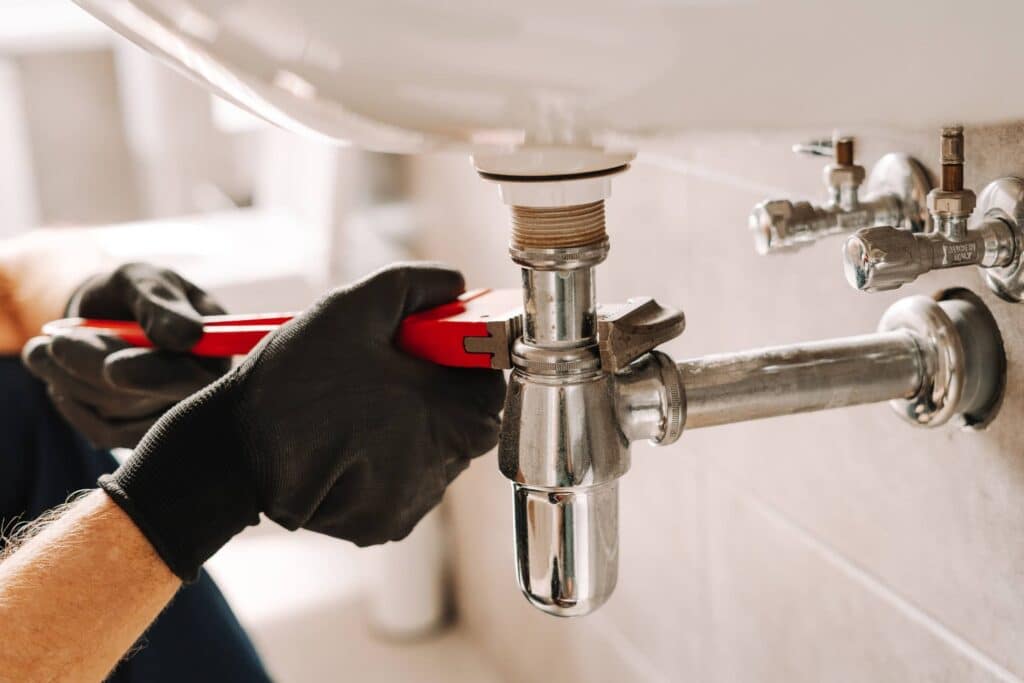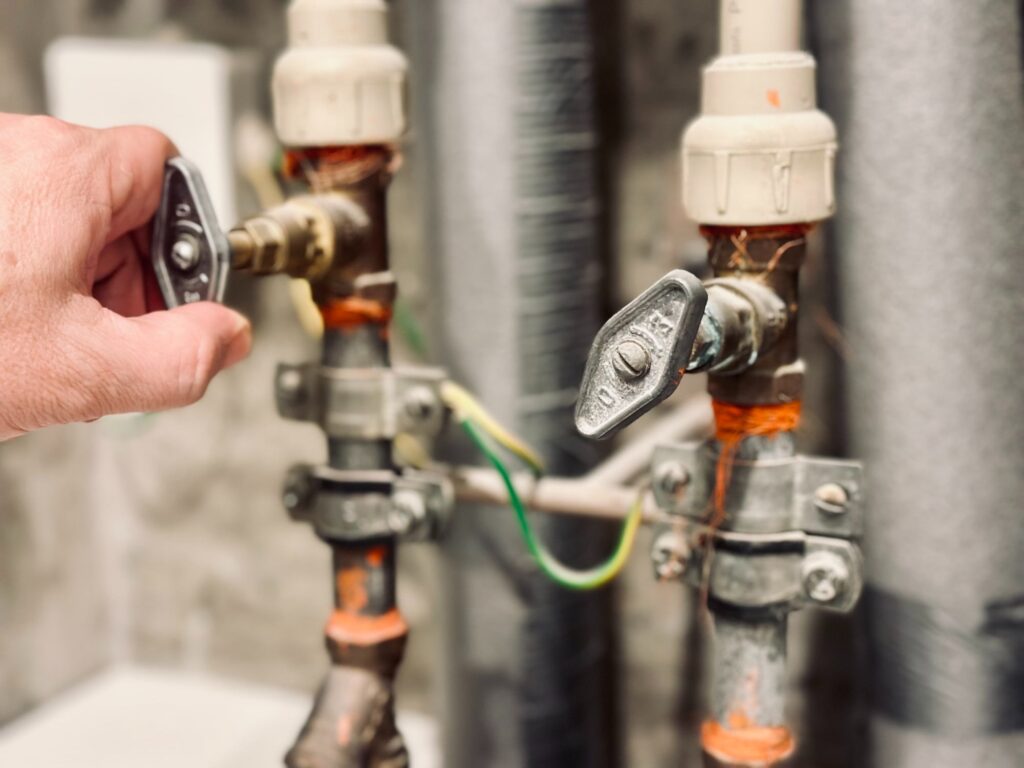Living in a paradise of warm, sandy beaches next to clear blue water comes with a price, and that price is the inevitable hurricane. While most homeowners understand how important it is to stock emergency supplies, board up the windows, and prepare for an evacuation, true storm readiness goes beyond the basics. Your home’s plumbing system is particularly vulnerable during hurricanes. With the right precautions, protecting the pipes can prevent costly and avoidable damage.
First Things First: Shutoff Valves
In a hurricane, the most important valve to find is the main shutoff valve, which will stop all water flow to the house. If you have a slab house, the valve may be near your water meter under a concrete or plastic lid. You may need special tools for this, so it’s best to keep them on hand in an emergency hurricane tool kit.
Homes with basements and crawl spaces can find the main shutoff valve on the main pipe entering the home outside. Newer homes may have this valve in the garage, in the utility room, or by the water heater. There are ball valves (a lever) or gate valves (a wheel). Turn the valve clockwise to close and counterclockwise to open.
It’s important to locate individual valves too for each sink, faucet, washer, dishwasher, and appliance connected to the plumbing system. They should each be tested to make sure that, in case of an emergency, they are not stuck and are easy enough to turn off. If there are any leaks, call a plumber to fix the issue.
Valve Checklist:
- Locate the main valve.
- Make a list of all sinks, toilets, and appliances that use a water line.
- Test each valve — call a plumber if there are leaks or issues.
- Label the valves with bright tags or tape, so they’re easy to find in the dark or during an emergency.
Drain and Winterize
Water heaters, pumps, and elevated tanks can become a problem if not prepped for increased flooding and water flow. Even though Florida doesn’t experience your typical winter, you still need to drain and winterize these fixtures prior to losing power. Even if all the following steps aren’t completed due to a time crunch, addressing as much as possible can help with a better outcome.
- Water heater: Turn off the power at the breaker or gas valve, which will prevent a dead unit if it runs dry. Using a bucket, drain a few gallons to relieve internal pressure.
- Irrigation and sprinkler systems: This is another part of your plumbing system that needs to be located. Shut off the different zone valves at the manifold (in addition to the main valve of the property). If time allows, use an air compressor to blow out the line or drain out the line. This can be done by opening the manual drain spigots.
- Pool and spa equipment: Turn off any pumps or filter systems. Lower the water level below the skimmer, but do not drain completely. Draining below the skimmer will prevent any overflow and damage, and keeping most of the water in the pool will help add weight and stability.
Reinforce and Inspect Pipes
Extra pressure from floodwater, shifting ground, and debris impact can lead to breaks in the pipes, even if prior to the storm, the plumbing was sound. Determine if there’s any weakness in the plumbing system and address these areas promptly.
- Visible piping inspection: Note any areas of rust, cracks, or corrosion on metal pipes (copper and steel). Check PVC fittings for sun damage or weak, brittle areas.
- Secure loose pipes: If there are any pipes in garages or basements, attempt to strap pipes to studs using cushioned clamps or pipe straps. This will prevent substantial movement that can cause pipes to shake apart.
- Potential upgrades: If there are any weaknesses or areas of concern, contact a plumber, especially if the home is older than 20 years old. PEX piping is a great option to replace copper and PVC, and it performs better with ground movement.
Sewer Backup Prevention
With increased water levels, the potential for sewage backing up into the plumbing is a very real threat, and it’s the last thing a homeowner wants to add to their problems after a severe storm. This is not only costly to repair and clean up, but it is also a health hazard.
- Install a backflow preventer: A backflow valve, or check valve, ensures that the flow of water is only out and doesn’t allow floodwater to creep in.
- Clean out caps: Clean out caps should be checked on a regular basis to ensure that they’re tight, intact, and void of debris. If caps are cracked or missing, they should be replaced.
Plumbing Emergency Kit
Having a go-to kit of necessary plumbing supplies is essential before a hurricane. With all the other storm prep tasks, this kit will come in handy.
Plumbing Kit Checklist:
- Silicone caulk or emergency plumbing tape: Self-infusing waterproof tape is perfect for emergency repairs.
- Adjustable wrench: Make sure it fits the fittings of your plumbing system. Include any other specialty tools needed for your valves.
- Hose washers and o-rings: These can be purchased at hardware stores in kits with a variety of sizes.
- Bucket, rags, and heavy-duty work gloves: These items may be needed to drain or clean around the pipes during storm preparations.
- Spare valve kit: Keep this on hand for that “just in case” emergency. When a storm hits, there won’t be time to get one from the store.
Insurance Questions
Your Homeowner’s policy should take care of the day-to-day emergencies, but only if the equipment is regularly maintained. It’s important to have the correct coverage for extenuating circumstances, such as the aftermath of a hurricane on the plumbing.
- Take pictures of your plumbing in good condition each time you do a replacement or quality check.
- Keep these pictures with your other storm prep docs in a waterproof bag, in a safe, or on the cloud.
- Ask about water coverage if flood insurance is not included.
- Discuss hurricane flooding scenarios to understand the fine print of deductibles and limits.
Wrapping It Up: Small Steps, Big Peace of Mind
A few hours spent locating and testing your valves, draining vulnerable systems, reinforcing or replacing sketchy pipes, and stashing emergency plumbing gear can make your storm week a lot less stressful.
- Label and test shutoffs.
- Drain and winterize.
- Inspect, strap, or upgrade.
- Prevent sewer backups.
- Pack a plumbing go‑bag.
- Document your prep.
Do this prep before the tropical storms start piling up on the five-day forecast. When that hurricane watch pops up, be ready to protect both your family and your home’s hidden network of pipes. Stay safe, stay dry, and keep your plumbing leak-free.



